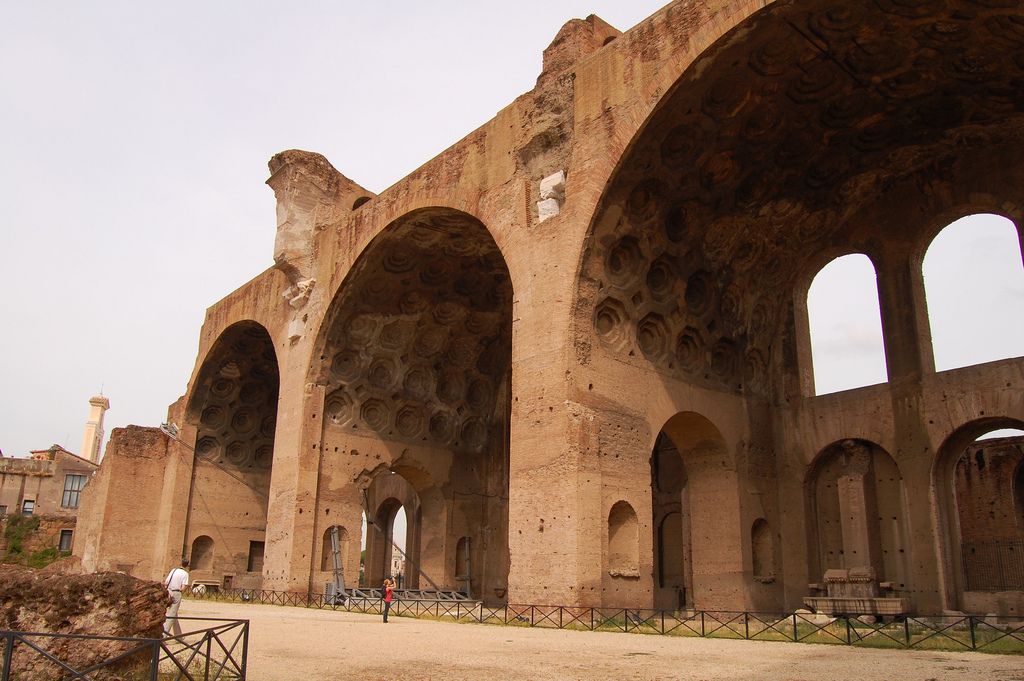
The Basilica Constantiana which is referred to as Old St. Peters Basilica was a church that stood from the 4th through 16th century, on the spot where the new St. Peter's Basilica stands today in Vatican City, Rome. It was also of the most important places to worship in the Catholic church. In this church you were free to be christian, and free to not be persecuted. The construction of the Basilica began in 308 C.E by Maxentius and finished by Constantine after he defeated Maxentius in the battle of Milvian Bridge in 312 B.C.
 |
| Basilica Constantiniana plan |
The Basilica is one of the most impressive buildings in the Roman forum. The ground plan is rectangular and the central nave is measured at 80 x 25m and was covered by 3 arches with a maximum height of 35m which is supported by eight monolithic Corinthian columns of 14.5m. The building consists of a central nave that is covered by three groin vaults suspended 39 meters above the floors on four large piers. Ending in an apse at the western end containing a colossal statue of Constantine (remnants of which are now in a courtyard of the Palazzo dei Conservatori of the Musei Capitolini). The lateral forces of the groin vaults were held by flanking aisles quantifying 23 by 17 metres (75 x 56 feet). The aisles were spanned by three semi-circular barrel vaults perpendicular to the nave, and narrow arcades ran parallel to the nave beneath the barrel vaults.
The nave itself quantified 25 metres by 80 metres (83 x 265 feet) engendering a 2000 square meter floor. Like the great imperial baths, the basilica made utilization of prodigious interior space with its emotional effect. Basilicas accommodated a variety of functions, including a cumulation of a court-house, council chamber and meeting hall. There might be, however, numerous statues of the gods exhibited in niches set into the walls. Under Constantine and his successors this type of building was culled as the substructure for the design of the more sizably voluminous places of Christian worship, presumably as the basilica form had fewer pagan sodalities than those of the designs of traditional Greco-Roman temples, and sanctioned sizably voluminous congregations. As a result of the building programmes of the Christian Roman emperors the term basilica later became largely synonymous with an immensely colossal church or cathedral.
Church Maxentius is a marvel of Roman engineering work. At the time of construction, it was the largest structure to be built and so is a building taking both aspects from Roman baths as well as typical Roman huge churches. At that time, it used the most advanced engineering ways of doing things known including inventions of new things taken from the Markets of Trajan and the Baths of Diocletian. Almost the same as many huge churches at the time such as Huge church Ulpia, Basilica Constantiana featured a huge open space in the central nave but unlike other huge churches instead of having comlumns support the ceiling of the whole building was built using arches, a much more common appearance in Roman baths than huge churches. Another difference from traditional huge churches is the roof of the structure. While traditional huge churches were built with a flat roof. Basilica Constantiana was built with a folded roof, decreasing rhe overall weight of the structure and decreasing the flat/left-and-right forces on the outer arches.
Works Cited:
[1] Bosman, Lex. The Power of Tradition: Spolia in the Architecture of St. Peter's in the Vatican
[2] http://sights.seindal.dk/sight/177_Basilica_Constantiniana.html
 |
| Basilica Constantiana Arches |
The nave itself quantified 25 metres by 80 metres (83 x 265 feet) engendering a 2000 square meter floor. Like the great imperial baths, the basilica made utilization of prodigious interior space with its emotional effect. Basilicas accommodated a variety of functions, including a cumulation of a court-house, council chamber and meeting hall. There might be, however, numerous statues of the gods exhibited in niches set into the walls. Under Constantine and his successors this type of building was culled as the substructure for the design of the more sizably voluminous places of Christian worship, presumably as the basilica form had fewer pagan sodalities than those of the designs of traditional Greco-Roman temples, and sanctioned sizably voluminous congregations. As a result of the building programmes of the Christian Roman emperors the term basilica later became largely synonymous with an immensely colossal church or cathedral.
 |
| Basilica Constantiniana Ruins |
Church Maxentius is a marvel of Roman engineering work. At the time of construction, it was the largest structure to be built and so is a building taking both aspects from Roman baths as well as typical Roman huge churches. At that time, it used the most advanced engineering ways of doing things known including inventions of new things taken from the Markets of Trajan and the Baths of Diocletian. Almost the same as many huge churches at the time such as Huge church Ulpia, Basilica Constantiana featured a huge open space in the central nave but unlike other huge churches instead of having comlumns support the ceiling of the whole building was built using arches, a much more common appearance in Roman baths than huge churches. Another difference from traditional huge churches is the roof of the structure. While traditional huge churches were built with a flat roof. Basilica Constantiana was built with a folded roof, decreasing rhe overall weight of the structure and decreasing the flat/left-and-right forces on the outer arches.
Works Cited:
[1] Bosman, Lex. The Power of Tradition: Spolia in the Architecture of St. Peter's in the Vatican
[2] http://sights.seindal.dk/sight/177_Basilica_Constantiniana.html
No comments:
Post a Comment